#visual studio 2012
Explore tagged Tumblr posts
Text
Visual Studio 2012 Update 4
Visual Studio 2012 için güncelleme 4 yayınlandı. Bu güncelleme ile aşağıdaki başlıklarda çeşitli sorunlar giderilmiş, detayları için bu sayfadan bilgi edinebilirsiniz. Continue reading Untitled

View On WordPress
#extensions & updates#fixed issues#güncelleme 4#giderilen hatalar#IDE#microsoft#update 4#visual studio 2012
0 notes
Text

#la luna#la luna 2012#dice tsutsumi#pixar#the art of pixar#pixar art#pixar animation studios#disney#art#concept art#visual development
19 notes
·
View notes
Text
Marina and the Diamonds - Bubblegum Bitch 2012
"Bubblegum Bitch" is a song by Welsh singer-songwriter Marina Diamandis, professionally known as Marina and formerly as Marina and the Diamonds, from her second studio album, Electra Heart (2012). Despite not having been released as a single, the song entered international charts after experiencing a resurgence on social media platform TikTok in early 2021, thanks to which it subsequently was certified gold in the US in March and silver in the UK in September the same year. The song was written by Diamandis and Nowels in June 2011 in Santa Monica, California, inspired by the book Bubblegum: The History of Plastic Pop by a British journalist, Nick Brownlee. Marina expressed her interest in releasing the song as a single in 2012, but she said that she could not do it due to the vulgar title, acknowledging radio constraints.
After returning from the US after the launch of her debut studio album in 2010, Diamandis considered creating a character which would become the centerpiece of her follow-up project. She commented that she was inspired by the "Tumblr generation" to photograph herself in several places across the US, appearing as a different persona in each picture to mimick the anonymity of the "mini-stars of the internet". The final product became "a cold, ruthless character who wasn't vulnerable", which she later named "Electra Heart" and detailed as a tool to represent a combination of elements associated with the American Dream and Greek tragedy, and added that visuals would merge the differing concepts into a cohesive idea. She originally planned to release the record as a "side project" under an entity separate from Marina and the Diamonds, although her management disapproved.
"Bubblegum Bitch" received a total of 88,8% yes votes!
youtube
650 notes
·
View notes
Text
Unreleased track and Secret Sessions
pairing: idol!jiyong x idol!reader
wordcount: 9k
2012
Before the world knew your name, the industry already did.
You were twenty-three and blazing through the charts with haunting vocals and visuals that made headlines every other day. A soloist without a company-crafted scandal or dating rumor, your mystique only made you more addictive to the public. You were the type to keep your head down and let the music speak, but even that couldn’t quiet the buzz. Every award stage you graced, every OST you lent your voice to—it was all becoming iconic. Quiet, elegant, untouchable.
That’s what they thought, anyway.
But somewhere across Seoul, in the smoke-filled dorm of BIGBANG, someone finally said your name out loud.
“Yo, have you heard that girl’s vocals?” Daesung said, waving his phone in Jiyong’s face. “You know—what’s her name again?”
“Y/N-ssi?” Youngbae offered, leaning back on the couch.
“That’s the one! She's everywhere lately. It’s insane. Her visuals are next level too, like—damn.” Daesung swiped through a gallery of screenshots from your recent music show performance, pausing on a still of you with your eyes closed mid-note.
Jiyong barely looked up from his notebook, pen scratching lyrics across the page. “Heard the name. Not the music.”
“You’re missing out,” Daesung chimed in, half-laughing. “She’s got this song—what’s it called? ‘Only If’ or something. Gave me chills. You’d like her stuff. Real emotional.”
That made Jiyong pause.
Chills?
He reached over and took Daesung’s phone, putting in one earbud. The moment your voice came through—soft, raw, heartbreak slipping into every line—he froze. His brows furrowed. The melody, the vocal control, the emotion—it was everything he admired in an artist.
“…She wrote this?” he asked, voice low.
Youngbae smirked. “Yeah. All of it. She’s legit.”
Jiyong didn’t answer. He just played the song again.
Then, later that night—alone in his room, still hearing your voice in his head—he opened his notes app and started typing:
to: Y/N
from: G-DRAGON
subject: collab?
A week later — YG Studio A, 2012
“Don’t freak out,” you told yourself, glancing at your reflection in the tinted glass door before pushing it open.
You weren’t the type to get starstruck. You had worked with legends, trained under pressure, performed on stages that demanded perfection. But this was different. This was G-Dragon. The same one who had texted your manager directly after hearing your song, requesting a meeting. The same one whose name was practically carved into the walls of Korean music history.
And now he was sitting across the studio—black beanie low on his head, legs crossed like he had all the time in the world.
He looked up as you stepped in.
And smiled.
"You're even quieter than I imagined," he said, standing.
You blinked. “And you’re less intimidating than I thought.”
That made him laugh. It was a soft sound, surprised—like he hadn’t expected you to say that.
“I mean that in a good way,” you added quickly, setting your lyric notebook down on the table between you.
He tilted his head. “That’s fair. People usually expect leather jackets and sunglasses.”
You smiled. “But you’re wearing both.”
He glanced at his outfit, then back at you. “Touché.”
The meeting was casual at first—small talk, compliments, the usual back-and-forth. But when the producer came in and asked about concept direction, everything shifted. You became serious. Jiyong noticed. You weren’t just a voice— you were a storyteller. You talked about wanting the album to explore duality. Beauty and bitterness. Love and loneliness. And he listened. Closely.
Halfway through the meeting, you offered a melody idea you’d written last night at 2 a.m., and Jiyong stopped scrolling his phone. He leaned in, asking to hear it again. Then again. Then he pulled his pen out and started writing beside you.
That was the beginning.
Not of the album.
Of the collaboration.
Of the story that would span four years and seventeen unreleased tracks.
Of the thing no one else knew.
Of the thing that would one day haunt Track Seventeen.
Flashback: Late 2012 — YG Studio Rooftop, 1:43 AM
"You didn’t have to stay,” you told him, the cold air biting your cheeks as you sipped your convenience store coffee. “You could’ve gone home.”
Jiyong shrugged beside you, hoodie pulled up, eyes squinting out at the dark city skyline. “Could say the same to you.”
Silence settled—comfortable, stretched between the buzz of caffeine and the high from a night of recording. You didn’t look at him, but you felt him watching you.
He said it so casually, like it wasn’t going to change everything.
“I think I like you.”
You turned your head, blinked. “You think?”
He smiled, lazy and slow. “Fine. I know.”
Flashback: Early 2013 — Jiyong’s Car, Late Night Drive
No cameras. No stylists. No producers.
Just you, him, and the quiet sound of your unreleased demo playing through his speakers. Your hand was in his lap, fingers interlocked, like it had always been that way.
“We’ll keep it between us, yeah?” he said softly, almost like he was asking for permission.
You nodded, knowing exactly what he meant. Not because you were ashamed—never that. But the world wasn’t kind to private things. Especially not when they bloomed between two public people.
Flashback: Summer 2014 — Somewhere in Europe
A getaway between tour dates. You two tucked away in a barely-used cabin in the south of France, rented under fake names.
There were no reporters. No staff. Just wine, sunburned shoulders, your laughter echoing off stone walls, and the sound of Jiyong humming in the shower.
That night, he wrote a song called “Sunlight Thief” after watching you dance barefoot across the wooden floor in nothing but one of his shirts.
You kissed him before he could finish the chorus.
Flashback: 2016 — Right Before the Breakup
A hotel room in Tokyo. The air smelled like room service and exhaustion.
He stood by the window, hands on his hips, head bowed.
“You’re leaving for the US tour,” he said. “And I’ve got comeback prep.”
“Yeah.”
“And after that…?” he asked, voice a little too soft.
You didn’t answer. You both knew the truth.
It wasn’t love that was the problem.
It was time. The lack of it. The demands that came from being artists first and lovers second.
So you hugged him that night like it was a goodbye.
Because it was.
Back to Present — 2025
Nobody ever knew.
There were no scandals. No blurry airport photos. No soft dispatch reveals.
Just seventeen tracks no one had ever heard.
Until now.
Until Track Seventeen dropped, and the world heard Kwon Jiyong moan your name like it was still stuck in his throat.
And maybe… it was.
The Internet Explodes
The album drops at midnight.
By 12:03 AM, “Track Seventeen” is trending in four countries.
By 12:07, fans are already uploading their reactions:
“EXCUSE ME DID HE JUST MOAN A NAME IN TRACK SEVENTEEN??”
“IS THAT A GIRL’S NAME OR AM I DELULU??”
“Bro this song is literally audio porn—what is happening???”
“Why is this sex song lowkey romantic? I’m gonna scream.”
“WAIT—IS THAT [Y/N’S STAGE NAME]??? 👀👀👀”
And then... someone posts a side-by-side audio clip.
Your voice in a 2014 demo run—breathy, soft, unmistakable.
And Jiyong’s moan at the bridge of Track Seventeen.
The tone. The syllables. The way his voice cracks just slightly.
It matches.
You’re trending before sunrise. Tagged in every post. Your latest Instagram photo flooded with comments like:
“TELL US YOU WERE THE MUSE WITHOUT TELLING US 😭🔥”
“How do you FEEL about being immortalized in track seventeen?? 👀”
“Did y’all hear the lyrics? The way he said ‘lace on your spine’ and ‘arched like my prayers were answered’—ma’am.”
“It was NOT just a collab back in the day I fear.”
Some fans are joking. Some are practically FBI agents. And some—some are simply streaming the song on repeat, hopelessly obsessed with the smutty, almost too intimate detail in every line.
You — 7:22 AM
You’re sitting in bed. Phone in your lap. Head spinning.
You didn’t sleep. How could you?
The moment you saw the title on the tracklist, your heart dropped. You knew.
And when you heard it—really heard it—when his voice dropped into that soft, sultry rasp and you heard your name whispered like a secret between teeth…
You almost dropped your phone.
Your body remembered things your heart tried to forget.
The lyrics?
They weren’t metaphor. They were memory.
The lace? That black backless dress you wore in Paris.
The moans? That one night in Jeju.
The last chorus? “Even now, I write you into every rhythm I ruin.”
God. You were ruined.
And now the world knew—maybe not everything. But enough.
Enough to make you want to text him.
Enough to make you scared that maybe… he left that track open for you.
And worst of all—enough to make you want to reply.
To: Kwon Jiyong
[Sent at 7:43 AM]
I listened to the album.
I wasn’t going to say anything, honestly. I figured we were past this—past us. But then Track Seventeen played. And Jiyong… you know what you did.
You moaned my name.
You didn’t even try to hide it.
I know that song. Not just the lyrics. I remember it—the breathless laughter, the lace on the hotel floor, the way your voice sounded right against my ear when you said you’d write a song about that night. I thought you were joking.
I don’t know if I should be mad or… touched. Probably both.
But if this is your way of reaching out—if this was for me—then you should’ve just called.
Or maybe you knew I’d hear it.
You always did know how to get my attention.
– You know who
From: Kwon Jiyong
[Sent at 8:11 AM]
I wasn’t sure you’d listen.
I wasn’t sure you’d recognize it.
But I guess I was wrong on both.
I didn’t write Track Seventeen for the charts, or for the label. Hell, I didn’t even write it for the fans.
I wrote it because I couldn’t keep it in anymore. You’ve been stuck in every chord, every half-finished lyric, every rough cut I’ve made since 2016.
I didn’t say your name to start drama. I said your name because no other one fit. No other name could’ve pulled that sound out of me, or that memory out of the dark. That night—it’s ours. And the track had to be ours, too.
I wanted you to hear it and know.
That I still remember.
That I’m still haunted.
If you’re willing, I’d like to see you. Just talk. No pressure, no expectations. Just… two artists who know each other too well, sitting in a studio again.
But if you say no, I’ll understand.
I just needed you to know—I meant every second of that song.
The Award Show – Present Day
The lights are blinding, the crowd is roaring, and your heart pounds like it’s trying to escape your chest. You’re standing in the green room after your stage performance, still glowing from the adrenaline—and from the fact that he’s here tonight. Kwon Jiyong.
You haven’t seen him in years. Not since you slipped out of his apartment in 2016 with his kiss still drying on your skin.
You’d seen the announcement earlier—he’d be performing. You hadn’t expected him to perform that song.
And yet, when the beat of Track Seventeen dropped halfway through his set, the entire arena stopped breathing. The sensual beat. The heavy, hungry lyrics. The way he moaned your name—drawn out and unapologetic. You felt like the whole industry just turned to you.
Now, as you try to slip out of the venue unnoticed, a hand catches your wrist.
You freeze.
You already know who it is.
“Running again?” His voice is soft, teasing—but there's a heat simmering just below it.
You turn slowly. He looks unfairly good in his tailored black suit, shirt undone just enough to reveal the tattoo that peaks beneath his collarbone.
You force a breath. “Didn’t think you’d catch me this time.”
He smiles—that smile. The one that used to pull the air right out of your lungs. “You dropped a whole album and disappeared. You really thought a moaned name wouldn’t get your attention?”
You roll your eyes, but your lips twitch. “Subtlety was never your strong suit.”
“I wasn’t trying to be subtle,” he says, stepping closer. His fingers graze your hip, light but claiming. “I wanted you to feel it.”
“And I did,” you whisper. “I felt everything.”
—
Author's note: so yea this fic is just basically jiyong moaning your name in an unreleased track
#bigbang x reader#bigbang#bigbang fanfic#kwon jiyong#gdragon#kwon jiyong x reader#gdragon x reader#kwon jiyong fic
113 notes
·
View notes
Text
Today is Day 9 Of Me Playing Girls' Frontline 2.
Like any other gacha, the start is braindead because they need even the most non-sentient of creatures to be able to clear. This is nothing new, but it really stuck out like a sore thumb in this particular case because this game heavily uses the XCOM formula as its inspiration. For the uninitiated, the original 1994 X-COM: UFO Defense starts incredibly brutal and only gets harder as you advance. The 2012 reboot, XCOM: Enemy Unknown starts reasonably brutal and scales pretty harshly and always demanding you really, really are learning what your tools can do and what the game mechanics are as you basically fight an asymmetrical Civilization III game against an opponent that 1) outguns you most of the way and 2) fights you with the hatefulness one only reserves for someone that has fucked one's wife. GFL2 starts you off against enemies that require absolutely no tactical acumen whatsoever, that do not use cover, and that deal pitiful amounts of damage even if you yourself don't use cover. This lasts a little too long for comfort but again it's industry standard. Once you get to parts of the game that require sentience, it's fun to see how they've gone about the flow of combat: You're basically pitting your characters with their own special conditions, specialties and passives against many enemies that initially are simple as hell (they just move and shoot) but steadily become more complex and nuanced (enemies that target an area for bombardment at the end of their turn, enemies that can counter in specific circumstance, enemies that trap your enemies with overwatch fire, reaction intereceptions, AoE, etc). The system definitely has potential. I've yet to truly find anything actually challenging that wasn't me fighting enemies 10-20 levels higher than my units, but the fundamentals of cover and risk-reward are there even on-level; if you get shot at completely exposed, you are going to take hefty damage (unless you are rocking a Suomi shield).
The biggest departure from XCOM proper is that there is no accuracy: All attacks will always hit, unless certain abilities outright deny the damage -- like certain enemy Medics that can use the Anesthesia skill to negate one instance of damage -- and the game really favors a more aggressive style for both the player and the enemy through the Stability System: All units have a Stability counter, which decreases by certain amounts depending on the attack received. Once it's depleted, units can only benefit from the most bare and basic defensive effects of cover, which are not very good. Stability Break also may have additional special effects on certain enemies, chiefly bosses, resulting in extra damage taken, reduced attack power, changing forms, losing certain active or passive skills, etc. As a huge fan of systems like this, I Enjoy.
The game is gorgeous looking: The environments are highly detailed, the character models are incredibly well made, the guns are lovingly sculpted. I know the overarching meme is that it's got the best anime girl feet in the industry -- and it's true, they put more love into rendering and modelling these girls' feet, stockings and socks that I've seen parents put into raising their children -- but the model quality is truly overarching, they spared no effort in any obvious area, it's a really gorgeous looking game. The sound design and the music are all fine and have not wowed me in any special way, really, but visually, good lord, the game truly does go hard. Another thing the game does really well is video cutscenes, the action and choreography of actually very decently lengthy cutscenes they show pretty often go very hard, with good explosions, good gunplay, fluid and good looking motions, etc. The animation direction in GFL2 is really, really good, something I wasn't expecting given they've not really delved on this area particularly in previous games. They probably hired a really good studio for this-slash-got themselves some very talented and skilled personnel for it.
The game economy is Post-Mihoyo style: There's a set cast of Max Rarity characters, called Elites in the game's nomenclature, that inhabit a Standard Banner with absolutely fucking horrendous rates. 0.6% chance of rolling anything Max Rarity, 0.3% of an Elite Doll, 0.3% of an Elite Weapon. Besides this, there's the Limited Banners, which is every banner ever, meaning post-launch Elites are all Limited with a Limited Signature Weapon. In other words, shit sucks. The only saving grace is that the game, in thankfully true XCOM fashion, is much less about having Strong Individual Units, and much more about having a team with good synergy, and there's plenty of great non-Elites you'll have plenty of copies of. Gameplaywise, you won't get shafted by not having the Newest Woman With A Broken Kit, which is good. Signature Weapons so far from what I've seen are very nice to have but no functionality is tied to them and no character feels incomplete without their Signature Weapon or without multiples dupes, which is really good practice and a deal breaker for me if it's present. About the only stupidly broken character I can think off right this second is definitely Suomi, who supports so incredibly well that she lets you Not Play XCOM. She's seriously and hilariously busted and futureproofed.
The writing is pretty damn stiff. This is nothing new with Sunborn. The thing with Sunborn is that when it hits highs, they are VERY high, but the trip to those highs is clunky and stiff, with an overabundance of nothingburger technobabble and tacticool filler dialogue that, were this a megahit the way One Piece is, would definitely inspire a dogged group of fans to make a website that tells you exactly where to read and where to skip to avoid all the meaningless filler. Even if you like some tacticool, it's just SO much of it that serves no purpose. The characters are... Unfortunately, not super fun. Our old friend Oats, ahem, Groza (OTs-14) is there, and she's fun, but the rest of the characters have not done a good job to endear me to them: Colphne I'm pretty ok with, Nemesis and Krolik really have exhausted the fucks I can give for them by this point (I'm in Chapter 4). This is particularly painful in the case of Nemesis for me, a character whose design I really, really love and who I was looking forward to a lot. Nemesis' whole thing is that she literally cannot speak normally and has to communicate entirely in cryptic theater kid ramblings, and Krolik conversely only exists as the only person that can somehow accurately decipher what the fuck it is she's saying. This is charming for all of three cutscenes before it becomes very old and basically filler: Nemesis says "The embers of starlight long forgotten by statues lingers in the fingertips of the deaf" and Krolik replies with "Hah!? Who are you calling a coward?! I'll beat you up!" because Nemesis shittalks Krolik a lot, and that's the crux of both of their personalities. I know they are building Nemesis for something else but good lord it's torturous and stale. There's a Super Powered Child that I don't care about and she's the main plot device. Mayling is funny and endearing, and I like her. We meet characters from Ye Olde GFL 1 days and so far it's been pretty nice every time: Suomi, Lenna (UMP9), Kalina, Leva (UMP45), always a good time hanging with them. I particularly enjoy how divorced Commander and Kalina are. Oh, the Commander (your character) is an actual character, fully voiced and all, I like that a lot, and I like them. You can choose a male or female Commander, with fully 3D rendered distinct non-obscured, non-masked models and that's pretty damn cool. Still, can't help but miss the bangers that were ST AR-15, RO635, DEFY, and others from GFL1.
There's plenty of stuff to do without using Stamina, especially event stuff, but I fear that once you run out of it, you enter that weird limbo of "logging in, autoclearing the RNG drops mode, logging out". I'm not there yet but I dread reaching it. I know they just launched the game here (1 year old in CN) but, I guess I've been immensely spoiled by Arknights' several replayable game modes, this game, being XCOM in nature, would ROCK a roguelite mode or some sort of replayable game mode so much.
Overall, it's been a pretty nice time, as someone who dropped but nonetheless greatly enjoyed GFL, it's great seeing the Old Friends better than ever. My friend Suomi and my friend Tololo (CHILE MENTIONED 🇨🇱🇨🇱🇨🇱) are there for me and I'm glad to hang out with them again. I wish my friend Sabrina would also join me sooner than later :'). Color me surprised that so far, the gameplay seems both fun and has potential, but we'll see how it goes from here. Overall: Good first impression.
Say something nice about my friend Tololo

86 notes
·
View notes
Text
Informative reminders about LIDENFILMS (Tokyo Revengers' animation studio):
In light of the TR season 4 announcement, here's some facts I happen to know about LIDENFILMS and would like to share:
- It's a small studio that only began operations in 2012.
- As far as has been observed, treats their workers fairly and gives them a reasonable/humane amount of work.
- Unafraid of animating LGBT content on mainstream shounen anime for TV!! Has handled TR very respectfully in this aspect. - Has workers so content that they have the will and time to be in the TR fandom too, drawing fanart and enjoying the characters outside studio time. I believe this is always a good sign.
- Has staff that cares greatly about the material. I've personally read directors giving extra contemplation to scenes, audio staff celebrating getting an emotional scene just right, and various expressions of effort and passion. I also believe this is a good sign.
LIDENFILMS also:
- Is heavily criticized for not having more high-budget time-consuming animation.
- Is often mocked for not being on par with high-budget shows in terms of visual detail.
- Still fits in wonderfully animated moments, just within constraints of their reasonable work times and manpower. Which, unfortunately but realistically, isn't every shot every episode.
- Again: in a gargantuan anime industry that sadly has NEVER been able to have animators unionize, as far as research shows, provides fair treatment.
- Again: goes places where TV-aired series/shounen do not regularly go. TR streams on Disney+ and the studio isn't on the best economic grounds and they STILL handle things that usually result in enormous industry pressure, such as lgbt themes.
Please consider these points!
150 notes
·
View notes
Note
I'm sorry, Life of Pi is about WHAT???
I see SOMEONE didn't have to read the book in 8th grade/watch the 2012 movie that basically destroyed the visual effect studio that made it/the 2023 broadway play with the cool puppets.
#ask#honestly i think the book is pretty tedious when it comes to it's thoughts about religion#and im more fascinated in the themes of how one views themselves versus who they have to be to survive#and depersonalization#but hey the puppets in the broadway play was really cool#got to see that one live
273 notes
·
View notes
Note
My thoughts on the audio are that I genuinely cannot come up with a sane explanation. I don't think Liam was necessarily in the studio but he has to be talking about him, right? Like IDK there was some visual effect or whatever, literally who else could be the cunt Noel doesn't want to see. Beyond which I am not a proper scholar so please let me know if I'm way off base but I have an extended divorce theory that goes:
2009: Breakup, they're both big mad for a minute
201?-2012: They are texting and like, sending their kids to the same school. possibly the most normal they've ever been.
2013-2015: Liam blows his entire life up and is extremely sad about the consequences of his own actions. I saw actual video footage of Noel saying that he's shocked beady eye broke up and he's actually sweet about it and tells Liam not to give up? who is this man. anyway while Liam will later claim Noel wasn't there for him during the divorce but as a general rule they're much nicer about each other when they're divorcing other people. this is where I become extremely conspiratorial because at some point they had to get the documentary off the ground and a second, more personal breakup is clearly going down around this time. I believe in their ability to deeply wound each other by playing cryptic telephone through the press but I think it genuinely makes more sense if they were actually talking, perhaps about a potential reunion.
2016-2020: supersonic documentary and also (coincidentally?) the apocalypse. Liam launches his solo career, Noel hates it and is pretty relentlessly mean about it and about Liam more generally. we are gearing up for the kind of tweeting/podcast commenting where you call your brother your ex-wife. I think this is also when Noel decides to drag Molly into it for some reason. Liam says publicly that he thinks Noel was waiting for him to hit rock bottom so he could be magnanimous about saving him. whether he thinks this because of something concrete noel did or said or because he's liam is a mystery. the Anais incident goes down, the vogue article comes out. we are never ever getting back together for real this time. noel says a bunch of normal and well adjusted stuff about how he wants Liam to die in a self driving car crash with Donald Trump and seeing his face makes him want to shoot up a MacDonalds.
2020-2022: the pandemic saves oasis. I'm serious. they're both stuck sitting at home with nothing to distract them from themselves and think of brighter days. apparently being trapped in a house with noel is genuinely so unbearable that Sara calls it quits (in the matter of Sara v. Noel I'm on her side). presumably this was cause for at least some self reflection. divorce is a lonely and difficult experience, sara and liam seem to legit hate each other in a way that would be a barrier to reconciliation (in the matter of Sara v. Liam I am also on her side but less so bcs she didn't get trapped in a house with him). at the same time Liam pulls off Knebworth 2022, demonstrating he can handle big events without headcasing (and without noel, and he will be doing those big events solo or otherwise). at this point I genuinely think it was just a matter of time before we were back, baybeee! let's hope they can keep it together.
bro your brain is so huge and deeply wrinkled, profoundly agree with all of this. why you on anon when your opinions are so correct and you could be sharing them with us directly tbh 👀.
but yeah, 100% covid saved oasis lmao. noel's divorce saved oasis. noel's miserable midlife crisis (ongoing) saved oasis 🥰🥰🥰. and it juuuuuust really seems like all those insane highs and lows that went on publicly in the media between them over the years probably, or at least quite possibly, had irl personal catalysts rather than just a general holdover of ill will from the 2000s. there are so many random little times one or both of them casually mentioned they were in contact, and any one of those instances can be disregarded, but when considered in retrospect from a collective standpoint..... AWFULLY DAMNING!!!
lots more to say about all of this actually, every point you've made is legit af and could be expounded upon for a hundred years, but it's midnight and im coming down with a flu (punishment for some kind of hubris im sure), so. thank you for all of this and goodnight 🙏
74 notes
·
View notes
Text
Milestone Monday










May 6th marks the first full week of May and with it, Great Lakes Awareness Day. Established in 2014, Great Lakes Awareness Day celebrates lakes Superior, Michigan, Huron, Erie, and Ontario and draws attention to water conservation and preservation efforts. In celebration of the day, we’re sharing artist Laura Brown’s (b. 1981) The Great Lakes of North America published in 2012 by Women’s Studio Workshop.
Women’s Studio Workshop describes The Great Lakes of North America as “. . . a visual examination of the Great Lakes region. Using layers of color reminiscent of a 1960’s school textbook, maps of the Lakes are rearranged and layered with routes traveled by French explorers, freight ships, and the artist’s own family.” The resulting double-pamphlet stitch is a vibrant record of the Great Lakes’ shoreline replete with noted natural landmarks like Pictured Rocks and Indiana Dunes.
Brown’s book was made in a limited edition of 50 copies signed by the artist during a residency at the Women’s Studio Workshop utilizing screen print, letterpress, wood block, and polymer relief printing.
Read other Milestone Monday posts here!
– Jenna, Special Collections Graduate Intern
#milestone monday#the great lakes of north america#great lakes appreciation day#laura brown#women's studio workshop#pictured rocks#indiana dunes#screen print#letterpress#wood block print#relief printing#artist book
110 notes
·
View notes
Text
Academy Award-winning film director James Cameron says his New Zealand citizenship is “imminent” and is hinting at plans to relocate to the country permanently to escape Donald Trump’s second term in the White House. Cameron, a Canadian born in Kapuskasing, Ont., and well-known for his slate of blockbuster movies including Titanic and Avatar, told New Zealand news outlet Stuff that he intends to make his farm in South Wairarapa his family’s primary residence. The film director, already a resident of New Zealand, has owned the 1,000-hectare dairy farm since 2012. He also has a history of professional ties to the island nation, having collaborated with Wellington-based visual effects studio Weta Visual on Avatar, for which it was awarded an Oscar.
Continue Reading
32 notes
·
View notes
Text
The weird and wonderful history of Kowloon as a digital interactive space - Part II
This article is the continuation of a previous post.

Any comprehensive history of 20th century Hong Kong is not complete without a chapter entirely dedicated to the architectural and urban planning puzzle that was Kowloon Walled City. Quite unlike any other slum in Asia or elsewhere in the world, the extreme conditions under which its inhabitants lived captured the attention of various international journalists and photographers whose reports of this accidental labyrinth, in turn, inspired some of the most remarkable artistic explorations of our time. In this regard, video games did not remain impervious to the powerfully stimulative imagery, as much a reference today as it was when its hardened concrete walls still stood tall.
Kowloon's Gate Suzaku VR - Jetman - 2017
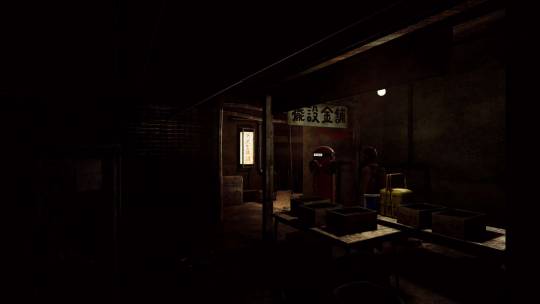
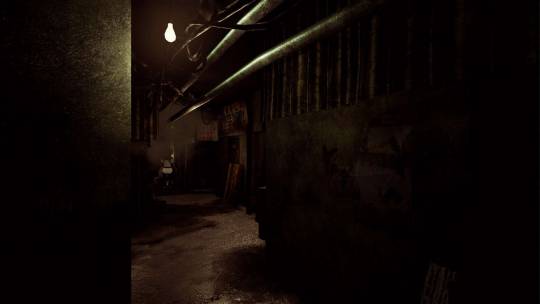
Kowloon's Gate made a most unexpected comeback twenty years after the original episode via the crowdfunded VR project Suzaku developed by Jetman, a studio founded by and composed almost exclusively of ex-SME/Zeque staff. While it is not the remaster many had hoped for, essentially consisting of a walking simulation through some redesigned locations from the original, it does a commendable job in faithfully replicating its instantly recognizable, light-starved alleyways in competent high-definition. It is also the only VR-compatible entry from this list, granting it a degree of uniqueness over its counterparts.
Stranglehold - Midway/Tiger Hill Productions - 2007
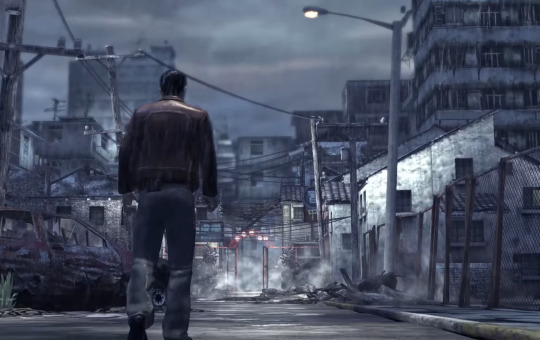
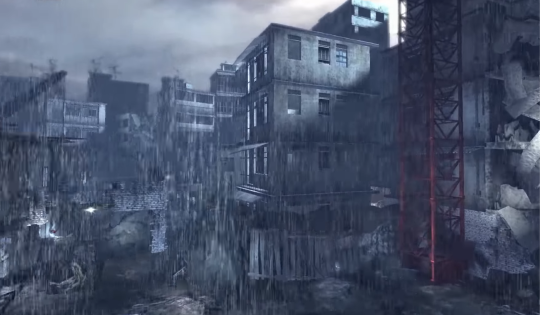
Stranglehold is the result of a collaboration with Hong Kong movie director John Woo, developed as a direct sequel to his heroic bloodshed classic Hard Boiled, featuring Chow Yun-fat in the role of detective 'Tequilla' Yuen in his unending confrontations with organized crime. One of the game's most unforgettable levels, Slums of Kowloon, takes place during a particularly rainy day, seemingly in those last days when the zone had been emptied of residents and demolition work was well underway. The visual representation of the quarter is suitably evocative, its buildings in complete state of disrepair, the remnants of local businesses or places of prayer still discernible from under the piles of steel and cement rubble.
Resident Evil 6 - Capcom - 2012
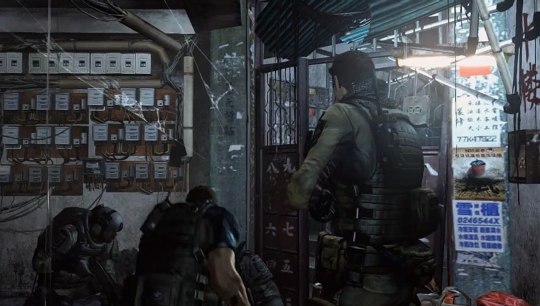
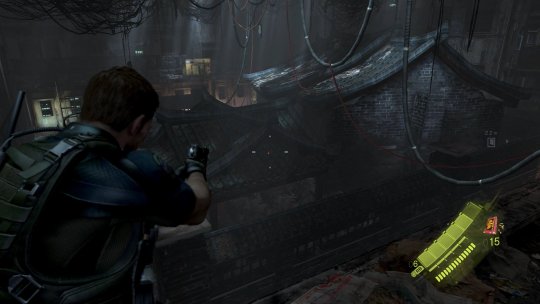
For all its shortcomings, Resident Evil 6 partly succeeds in taking the first two episodes' concept of parallel storylines and realizing it to a much fuller extent. Its choice of different characters translates into entirely different campaigns, locations and playing styles. The very first scene in Chris/Piers' campaign occurs in the fictional Chinese city of Lanshiang, modelled after real-life Hong Kong. The mayhem in the main streets forces the player to take a detour into a location named Poisawan, which bears a striking resemblance to the Kowloon district. Though an unofficial representation, it is among the most skilled replications of the scenery we find in the vast photographic repository of the area. The degree of minutiae with which the district's haphazard electric installation is replicated, alone, suffices to demonstrate a true commitment to authenticity.
Paranormal HK - Ghostpie Studio - 2020


Few would dispute that Kowloon is, itself, naturally conducive to sentiments of dread and anxiety. Paranormal HK is a 2020 made in China production reviving the defunct neighbourhood in a gripping, blood-curdling contemporary ghost story. The player is the cameraman of a paranormal-themed TV show exploring the zone during the evening of the Zhongyuan festival, a scheme suspiciously akin to that of Akira Ueda's 2004 game, Michigan: Report From Hell. As a result of the thorough research work performed by its creators, as well as the impeccable usage of contemporary 3D graphics techniques to achieve accurate lighting conditions, players may momentarily experience the feeling of walking into a photo of the actual city as it existed in the mid eighties.
Sifu - Sloclap - 2022
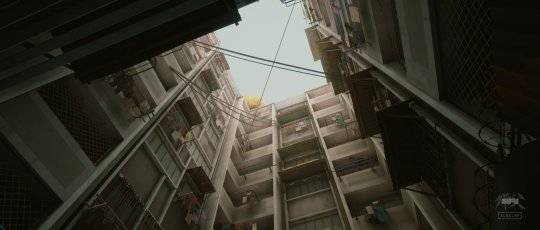
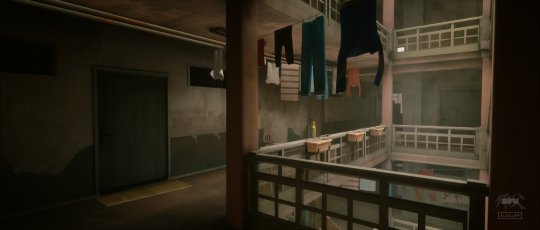

Notwithstanding of its renaissance during the 128-Bit era, the beat 'em up genre is commonly associated with the arcade games of the late 80s and 90s, the period of time when it flourished and, arguably, reached its zenith. The simplicity of controls and ease of access sufficed to attract players to the arcade cabinet, while the frequently extreme levels of difficulty of advanced levels ensured a steady flow of cash for arcade room owners and game development companies alike. Nevertheless, the genre has but perished and, in many aspects, recent years have indeed elevated it to unforeseeable degrees of complexity. Sifu, by Sloclap, synthesizes the elation of digital hand to hand combat simulation with the real-life complexity of mastering a martial art.
As is the case of previous entries in this list, Sifu makes no admitted reference to Kowloon or Hong Kong. However, the designers left little to the imagination in what pertains to their inspirations when taking on the task of constructing the game's environments. Another notable coincidence stems from the fact that this production was made possibly with the support from a celebrated independent game funding group going by the name Kowloon Nights.
Stray - BlueTwelve Studio - 2022


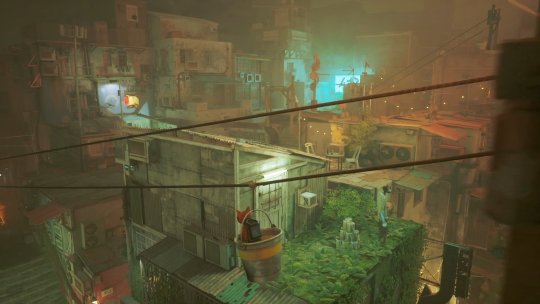
Stray is one of the most revered independent video games in recent memory, and justifiably so. The long development process yielded many benefits, judging from the consistency and attention to detail that engrossed many an avid player. That the main character is singularly charming feline may have played an equally crucial role. The creators have made no effort to conceal the fact that the notorious Hong Kong district was a pivotal influence to the design of its nameless city. The first indication can be spotted in the game's earliest footage, in which a black cat traverses a street where a particularly conspicuous sign boasted the initials HK. Stray is less concerned with presenting a precise replica of Kowloon than it is about summoning the very essence of its atmosphere. Moreover, in an exquisitely poignant way, its ending lends an entirely new meaning to the term walled city. In the future, robots may well take the place of humans. Invariably, the Walled City is no more. Slitterhead - Bokeh Game Studio - Work in Progress
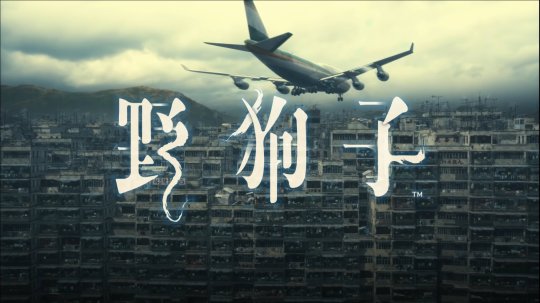

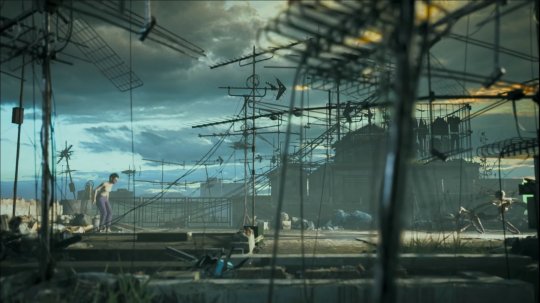
An sequence of unconscionable mistakes from the part of Sony Computer Entertainment's management galvanized Keiichiro Toyama to part ways with Japan Studio, as it once was, and establish his own game production label. Their debut title, Slitterhead, is described as a grotesque survival horror experience, a genre within which the author moves with matchless ease. Among the few certainties regarding this project is the fact that it will take place prominently - if not exclusively - within the Kowloon City province. A wide variety of aspects included in the preview footage leave the viewer optimistic as to this being one of the most accomplished portrayals of the district ever seen in a video game. Subtle yet telling signs already demonstrate the creator's in-depth knowledge of the quarter's architecture and history. Take, for instance, the suggestive image of the airplane flying mere meters above the top of the buildings. Although the growth of Kowloon was for the most part ungoverned, buildings did not rise above a certain height, even as inhabitants claimed for increased availability of space. This is due to the fact that airplanes landing at the nearby airport would be required to make their descent at relatively low altitude, performing a tight curve as they soared just above the enclave, thus preventing construction from expanding upwards. Another scene shows a child playing on the rooftops of the buildings, which once again is consistent with the documented habits of residents who, starved for sunlight and open space elsewhere within the city limits, had little alternative than to take the stairs all the way to the top.
Warehouse Kawasaki Arcade
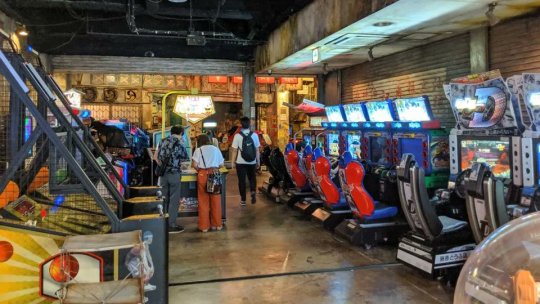
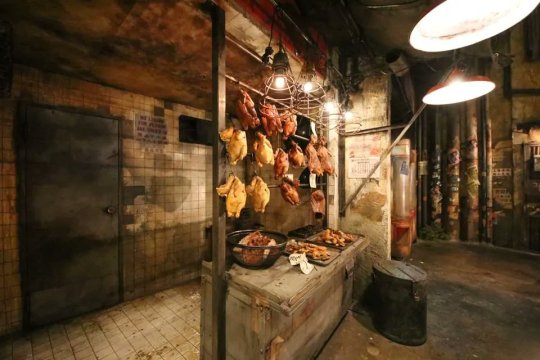
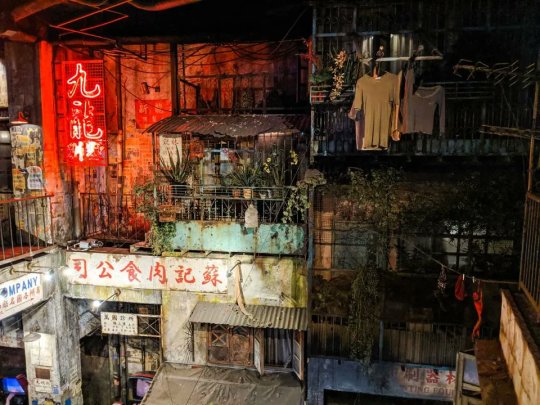
I would be remiss not to make some form of allusion to Warehouse Kawasaki, an arcade built to replicate the Walled City with unthinkable detail. Though its ultimate purpose was for visitors to engage in digital entertainment, the venue was scrupulously put together. Point in fact, many of the objects used in the construction of the five floor amusement centre were imported directly from Hong Kong. Like so many other Japanese arcades, it closed its doors in 2019.
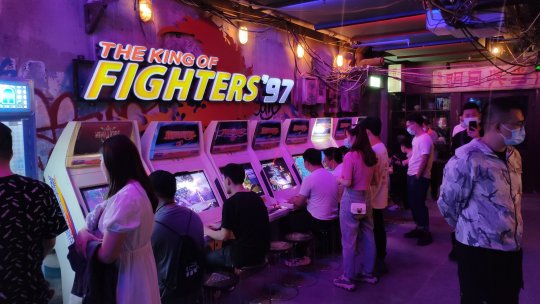
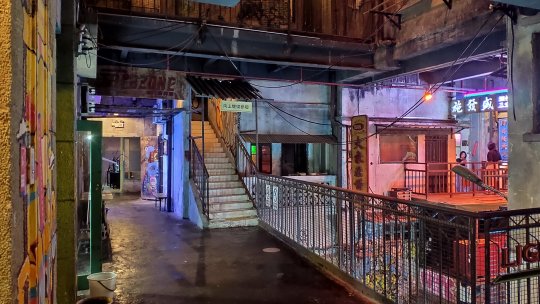
In recent years, a rather similar initiative was taken by the Chinese in their attempts to build unique mall spaces. The 文和友 malls in mainland China, found in Changsha, Guangzhou and Shenzhen, attempt to reproduce the walled city aesthetic. Local residents inform me that these are increasingly lacking in foot traffic, for which reason the majority of their stores are closed. Other digital replicas of Kowloon
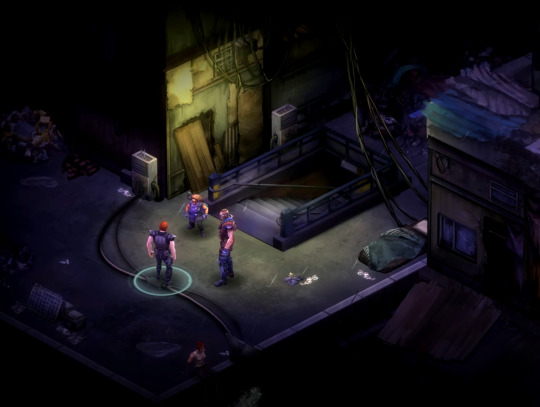
A number of other videogames set in or deriving inspiration from Kowloon could not be featured in this article. A frequently cited reference in this context is the action/adventure game Fear Effect, one which I emphatically dispute. No doubt remains as to it being located in a futuristic version of Hong Kong, yet I could discern no parallels with the walled city, save for those scattered second-hand visual motifs that were no doubt imported from sci-fi classics such as Blade Runner or Ghost in the Shell.
The Utelek Complex stage of Deus Ex: Makind Divided presents a similar situation, where the overall atmosphere of the futuristic favela bears some resemblance to Kowloon, without meeting the specificity quota that would warrant a more comprehensive exploration.
The 2004 Shout! original Kowloon High-School Chronicle for the PS2 is a unique case, in that it borrows the city's name despite taking place in a massive, Tokyo underground dungeon that is later revealed to be a maze-like Egyptian pyramid. The odd choice of title remains unclear. Shadowrun: Hong Kong game (screenshot above) contains a very direct mention of Kowloon as the place in which an entire episode comes to pass. Another project still in development, Kowloon's Curse (screenshot below), is following the lead of many popular independent horror games in recent memory by using a visual design and structure that elicits memories of the late Playstation/early Dreamcast era. A short prequel episode was made available earlier this year, for free.
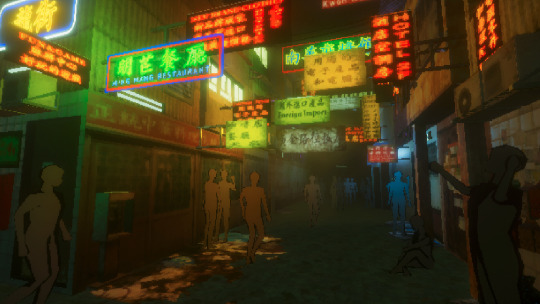
Additionally, I refrained from mentioning the Kowloon maps in Call of Duty: Black Ops or Counter-Strike: Global Offensive, as I perceive both games to be insufficiently relevant to merit study or contemplation.
A space that refuses to be forgotten
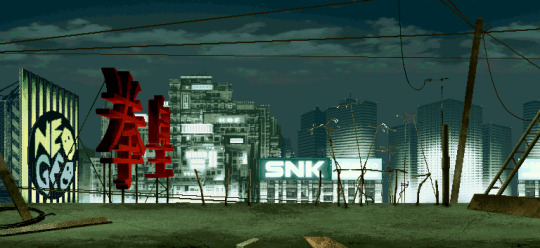
(China rooftop stage from The King of Fighters 2003)
It would be a gross overstatement to claim that Kowloon is a recurring location or level design motif in videogames. The relationship between digital games and the real life ghetto has been one of sporadic references. What makes the subject so engrossing pertains to the quality of the relationship, particularly that of a small cadre from among the titles featured in this article. Kowloon's Gate was one of the most relevant game creations of the 32-Bit era, a game deserving of reverence and cult following inside and outside Japan. Likewise, Shenmue II is the second instalment of a truly ground-breaking and highly advertised series whose production costs alone were unmatched until quite recently.
Moreover, this is an affair that is far from concluded. The unexpectedly high number of allusions to Kowloon in videogames released or revealed just last yet demonstrates that its aesthetic is still very much present in the minds and hearts of artists and designers working in the field. The walled city lives on as a digital demarcation that is certain to resurface time and again in years to come.
#kowloon's gate#kowloon's gate VR suzaku#jetman#stranglehold#john woo#kowloon walled city#hong kong#resident evil 6#poisawan#paranormal hk#ghostpie studio#sifu#kowloon nights#stray#slitterhead#bokeh game studio#keiichiro toyama#Warehouse Kawasaki#arcade#文和友
217 notes
·
View notes
Text

#pixar#pixar animation studios#the art of pixar#disney#pixar art#art#concept art#visual development#character design#Carter Goodrich#brave#brave 2012
7 notes
·
View notes
Text
HUgE Oct 2012
PHOTO SESSION with HYSTERIC GLAMOUR
Jack White
&
HYSTERIC D.C. goes to NASHVILLE for JACK WHITE.

Thee Hysteric XXX Shirt "reference item, Trygod for HYSTERIC GLAMOUR Ring ¥79,800 (HYSTERIC GLAMOUR)

Thee Hysteric XXX Cardigan ¥37,800, Slacks ¥33,600, Shirt
reference item (HYSTERIC GLAMOUR)


Thee Hysteric XXX Jacket ¥60,900, Slacks ¥33,600, Shirt *reference item (HYSTERIC GLAMOUR)


Thee Hysteric XXX Blouson ¥102,900, Slacks ¥33,600, Shirt *reference item (HYSTERIC GLAMOUR)

The seasonal catalogue for HYSTERIC GLAMOUR began in the spring of 2007. This series, which was derived from campaign visuals, continues to be recorded as a photo book every season. The director, Nobuhiko Kitamura, selected photographer WATARU and stylist Tsuyoshi Noguchi as the photography staff. The first season began in Coney Island, New York, and the photography crew later became demo shoots. After that, the setting for the shoot shifted to rock city Detroit, the birthplace of Iggy & the Stooges and MC5, whom Kitamura has admired since childhood. After meeting Niagara, the frontman of Destroy All Monsters, Jim Shaw, a Detroit rock mastermind who actively introduced the then unknown Goreys and White Stripes, supported Kitamura's photography and deepened his bonds with the people he met in Detroit with each shoot. Kitamura refers to this series of events as "HYSTERIC D.C. (DETROIT CONNECTION)."
With each passing season, the film crew becomes more and more united, holding sessions with the models and local artists they meet in each location. It is no exaggeration to say that the vivid visuals born from recording the atmosphere on location, as if cutting out a fragment of their own travels, have shaped the visuals of HYSTERIC GLAMOUR for the past five years.
This May, the brand chose New York, New Orleans, and Nashville as the locations for its seventh visual shoot. Starting with a shoot for the kids' line in New Jersey, a suburb of New York, the brand went on to a photoshoot for the women's line in New Orleans with top Texas model Ashley Smith and her three daughters, Camille and Zuzana.
With "OY" still in the background, the film crew headed to Nashville, where he currently resides, to meet Jack White.
In 2010, when Jack White came to Japan for a Dead Weather concert, he was introduced to Jack by his friend Alison Mosshart (who is a member of The Kills and is also a member of The Dead Weather, and whose mother is from Detroit and will soon be moving from London to Nashville), and Kitamura and photographer WATARU met Jack for the first time during an interview for HUGE issue 70. When they showed Jack, who is from Detroit, several seasonal catalogs that they had photographed in Detroit, they began talking about the elementary school he attended and the familiar diner that his family used to go to, which were in the background of the photos, and they hit it off despite it being their first meeting. The night after the concert, all the members hung out at the bar "Red Shoes" in Aoyama.
With this background, and with the help of Jack's nephew, Ben Blackwell, also from Detroit, the photo session introduced in this issue of HUGE was made possible in the studio of "Third Man Records," the independent label founded by Jack and run by Ben.
Just before noon on June 4th, the film crew departed by car from a hotel in Nashville. They arrived at Third Man Records, passing Hume-Fogg High School, the same school attended by Bettie Page, Kitamura's favorite and one of the icons of Hysteric Glamour. At the factory-like building's entrance is a small goods shop run by the label. We pass through a store packed with vinyl records released by Third Man Records and original turntables, and are shown to an office in the back yard. The spacious, high-ceilinged space has black-painted ceilings and walls, a kitchen with checkered tiles like a 50s diner, heavy leather sofas, and an array of stuffed animal specimens and bones.

*Looking down at downtown Nashville from the slope in front of Third Man Records. A recording studio is under construction in the building next to the studio, and you can sense Jack's determination to settle down and live here.
The drawing space where Jack exudes a strong presence and the staff workspace are neatly laid out. It's a shame that we can't show you anything here because photography is not allowed in the office, but in the center of the room is a vintage turntable and a giant speaker. Behind the scenes of using all vintage equipment to create his own music and producing his own records and turntables, you can feel Jack's strong will towards music, projecting the music and culture of the good old days of America onto himself.
At the back of the space, there is a fully equipped blue horizon studio and stage. This is the same place where the photo shoot for the record jacket released by Third Man Records was held.
There was a tense atmosphere while the crew waited for Jack to arrive at the studio. However, the female staff at Third Man Records were all very welcoming and made the atmosphere relaxed despite the tension.
At 1pm, Jack finally appears in the studio! After finishing his hair, makeup and styling, the photo session begins. Jack casually picks up his blue horizontal and his favorite acoustic guitar and begins to sing. His assistant Mindy drops the needle on the record for his solo album "Blunderbuss" on the DJ set placed on the stage inside the studio. Jack unconsciously begins to play the guitar along with the intro to "Missing Pieces." The only sounds echoing in the studio are his guitar, his singing voice and the click of photographer WATARU's camera. After shooting there for about an hour, WATARU asks Jack if they could take photos while walking around the neighborhood near the studio. Jack gladly agrees, and the film crew continue shooting as they stagger up the slope in front of the studio. Then, During the shoot, groupie girls waiting for Jack outside the label tried to take pictures of him with their cell phones, but Mindy quickly and smartly took care of them. Even in such small details, you can feel the stoic attitude that is consistent with Third Man Records' consistent sound and worldview. The peaceful atmosphere on set between Jack and the label staff, and the film crew also blended in with the atmosphere, and before you know it, three hours had passed and everything was finished.
After New York and New Orleans, the group finished their filming trip in Nashville. As they were shooting with Jack, who had just returned from a live tour and was extremely busy, the next day, which was meant to be a backup day for his shoot, was a brief day off. On the night of the shoot, they went to see a live performance by Ghost Wolves, a band from Austin, Texas, with Ben and the others at a local live house called "THE BASEMENT". The next day, Ben invited the filming staff to his home, and they relaxed in his garden under clear skies. Finally, Ben's wife Melissa took us to the bar "FAN'S EAST SIDE". The worn-out one-story store, located right next to the tracks where long-distance trains run, is decorated with paper decorations and neon beer signs, and local customers are relaxing while working on the jukebox and playing billiards. Ben and the others joined them after finishing work. In the store, where the setting sun shines in, the people who helped with the shoot are intoxicated with the music on the jukebox and the drinks. The film crew concluded their trip to Nashville in this place that could be described as a picture-perfect example of Nashville's pristine scenery.
Nashville is a city where music is always resonating somewhere, day or night, transcending races such as black or white, and genres such as country and rock. By interacting with people who are immersed in music and Tennessee whiskey and who live their lives in a localized way, Jack has come to live a life that is more intimately connected to music.
Perhaps we could sense at least a little of his feelings of choosing Nashville as the place to meet. Nashville is a city loved by many musicians such as Bob Dylan and Johnny Cash, and is a mecca for music culture in America. After multiple shooting tours with people connected by the common language of "Detroit," Kitamura was able to meet Jack White, who lives here today, and this must have completed "HYSTERIC D.C." for him as a culmination. Hysteric Glamour will be celebrating its 30th anniversary in 2014. What is the vision that this brand has for the future? We can't help but look forward to the future.

The day after the shoot with Jack, my nephew Ben
Film crew relaxing in their garden
#my scans#fashion#2010s fashion#archive fashion#japanese fashion#hysteric glamour#jack white#nashville
10 notes
·
View notes
Text

Why These Imperfect Korean ‘Moon Jars’ Sell for Millions
Old, round, imperfect and beautiful — that’s how fans of Korean art describe the moon jar, or “dalhangari.”
These unassuming, plain white pots have entranced everyone from rapper RM, of K-pop sensation BTS, to philosopher Alain de Botton.
The former director of London’s Victoria and Albert Museum, Beth McKillop, has called the moon jar an “icon of Korean identity.” And if price is any indicator of popularity, one recently sold for over $4.5 million at a Christie’s auction.
This month, a rare example from the late 17th or early 18th century will go on sale at Sotheby’s in New York, where it’s expected to fetch more than $3 million.
“A large moon jar has always been expensive, but I think the big uptick in prices and value is… because their appeal is now global,” said Angela McAteer, Sotheby’s international head of Chinese art for the Americas and Europe, over video call. “You’ve got an international cohort of bidders competing for them, so it’s gone beyond the traditional connoisseur collecting community of Korean art.”
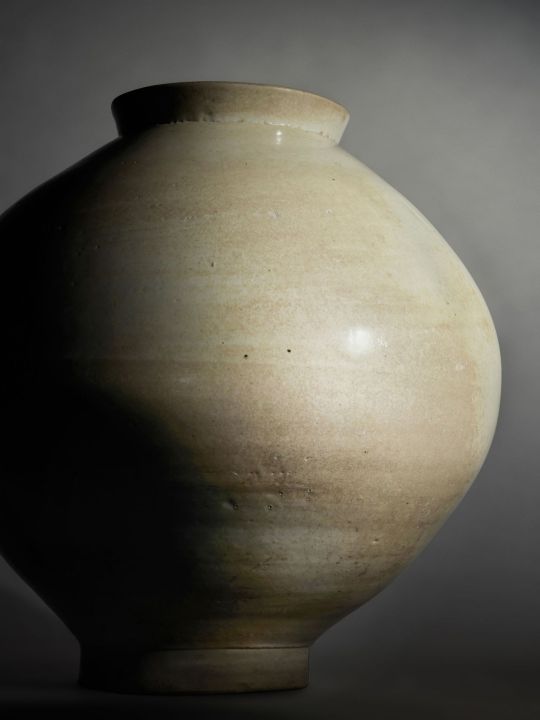
Huge price tags also result from the jars’ rarity. Although made for over a century in the royal kilns of Korea’s last kingdom, the Joseon dynasty, few are thought to exist today. Estimates for the number of larger ones (those more than 40 centimeters, or 15.7 inches, tall and wide) that have survived over the years range from 12 to 30.
Having passed through auction houses and antique dealers across the world, several of these are now in the collections of institutions like the British Museum and Boston’s Museum of Fine Arts, as well as in the hands of private collectors.
‘Owning a piece of happiness’
The first moon jars were created in the royal kilns in Gwangju (a city just outside Seoul, not the larger southern city of the same name) from 1650 to 1750. They were made from pure white porcelain and kaolin clay, and, following the neo-Confucian fashions of their day, the pots reflected values such as propriety, humility, frugality and purity. They were likely used at court and in upper-class homes as containers for food and liquids, or as decorative vessels.
In the mid-20th century, moon jars began gaining international appreciation thanks to influential admirers such as Japanese folk crafts scholar Yanagi Soetsu and British potter Bernard Leach, who bought one from a Seoul antique store in 1935. Leach once said that having a moon jar was like “owning a piece of happiness,” and would later give his to fellow potter Lucie Rie for safekeeping during World War II. It stayed in her studio until her death and was later acquired by the British Museum.
Charlotte Horlyck, lecturer in Korean Art History at the University of London’s School of Oriental and African Studies, wrote in the Art Bulletin journal that after World War II the moon jar “caught the attention of an early generation of postcolonial Korean artists and scholars who sought to restore Korean art history and national identity,” as the pieces “resonated with the visual language of international modernism and minimalism of the mid-20th century while remaining a distinctly Korean work of art.”
The moon jar’s allure
When Sotheby’s announced its forthcoming sale, the auction house described its 44-centimeter (17.3-inch) moon jar as an object that inspired, astounded and soothed those who “stand in its presence.” It’s a funny thing to say about a pot, to speak as if it’s alive, but the jars’ visceral, emotional impact on people is something that comes up time and time again in the literature.

Choi Sunu, a former director of the National Museum of Korea, has described the museum’s moon jars as being like companions, or muses that have inspired his writing and stirred his creativity. Bernard Leach admired the pots for their “natural unselfconsciousness.” In 2012, South Korea’s then-Unification Minister Yu Woo-ik used the pot as a metaphor symbolizing a reunified Korean peninsula (moon jars are created in two hemispherical pieces and joined in the middle).
More recently the rapper RM, of K-pop group BTS, posted a picture of himself hugging a modern-day moon jar on Twitter, telling fans that the pots made him feel calm.
“It’s hard for someone to really comprehend how a pot can make you feel that way,” said McAteer. “It has this real meditative presence. If you’ve sat in front of a great (painting by US artist, Mark) Rothko and you feel this kind of palpable energy emanate from it, and you could sit for hours and just feel something in its presence — the moon jar has that too.”
“The more you look at it, the more there is to see. It looks different from every angle,” she added. “We had real issues with the photography and the catalog because it looks like a different piece every time you rotate it, or you change the lighting. The surface is just alive, you know.”
“You can see how the glaze coalesces; you see these spontaneous bursts of this blush color that’s happening in the firing. You can lose yourself in its surface.”
Modern masters
Modern Korean potters have been inspired by the jars, and a number have come up with their own homages. Ceramist Kim Syyong covers his pots with a black glaze, while Yun Ju Cheol’s versions look spikier like a pufferfish and Choi Bo Ram’s unvarnished, textured blue vases have a denim-like quality.
Others, like Kwon Dae Sup, have looked to closely recreate the process used by the potters of yore. The 71-year-old ceramist produces unadorned white jars and allows for all the beautiful imperfections produced to shine through. He works out of a studio in Gwangju, where the royal kilns that produced moon jars were once located.

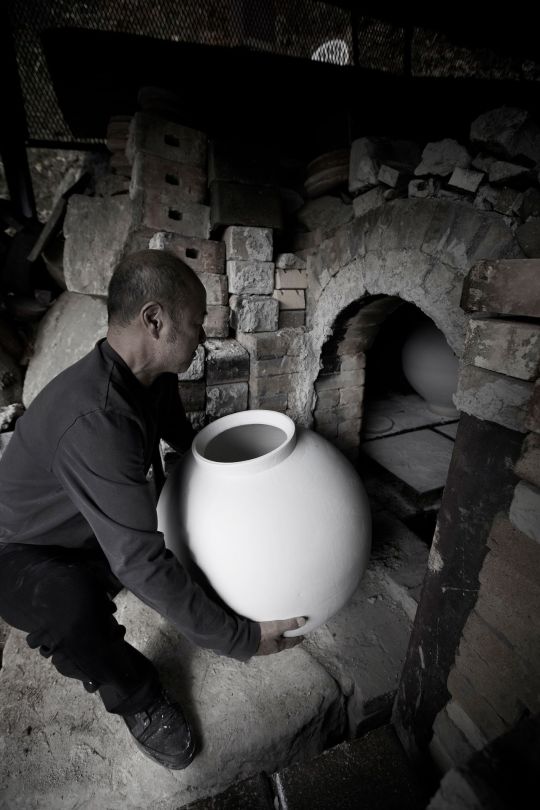
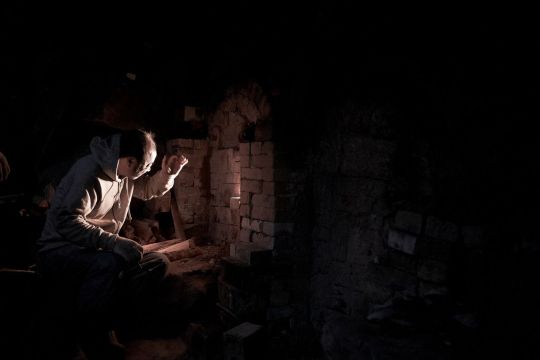
There’s a great deal of preparation that goes into making a moon jar traditionally. It’s labor-intensive: washing, sifting impurities from the clay, kneading and rolling it to remove air bubbles, carrying around these large hunks, not to mention hand throwing the clay itself to that oversized bowl shape without collapsing, and the work keeping a pine wood fire burning for 24 hours while the pot hardens in the kiln. Kwon also built his own kiln to replicate the old process as closely as possible.
“I do this because it’s fun,” he said in a phone interview. “Every time I make something, it’s novel … The quality of the material is different every time. The conditions in which I make the pots is new every time.”
Kwon said he also feels an emotional connection to the moon jar. As a student he was so moved by a one he saw in a Korean antique store that he decided they would be his life’s work. “They feel alive,” he said.
In a 2019 book on his work by Axel Vervoodt Gallery the potter is quoted saying he tries to produce art that needs no addition or subtraction. “I wish to create work that has an imposing presence but harmonizes with its surroundings regardless of where and when it is displayed. It should give peace of mind and a sense of comfort to all who look at it.”
By Christy Choi.
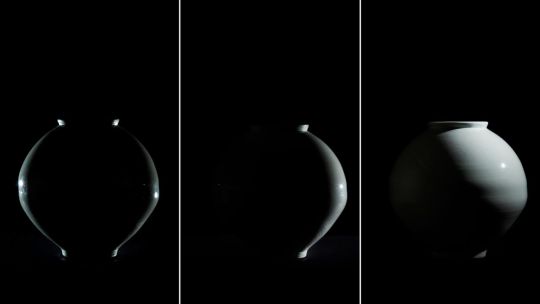
#Moon Jars#Why These Imperfect Korean ‘Moon Jars’ Sell for Millions#Dalhangari#Joseon dynasty#pottery#porcelain#Bernard Leach#Lucie Rie#Kwon Dae Sup#ancient artifacts#archeology#archeolgst#history#history news#ancient history#ancient culture#ancient civilizations#korean history#korean art#art#artist#art work#art world#art news#long reads
153 notes
·
View notes
Text

Iwona Demko (PL, b.1974)
Damp Lady, 2014
Sculpture; shiny fabric, plastic
follow @iwonadem
www.iwonademko.pl
Born on the 66th anniversary of finding Venus of Willendorf-August 7, 1974 in Sanok. She graduated from the Sculpture Department at the Academy of Fine Arts in Krakow. Now she works at her alma mater with the title of habilitated doctor.
2016 - the title of doctor habilitated in the field of visual arts, in the discipline of fine arts
2012 - the title of doctor of fine arts in the artistic discipline "beautiful art" on the basis of the doctoral dissertation titled "Waginatyzm" and sculptural work entitled "Chapel of the Vagina" from 2008 - assistant at the Sculpture Department of the Academy of Fine Arts in Krakow 2001 - diploma with distinction in the studio of prof. via invaluable
#iwonademko #sztukakobiet #vaginamuseum #womensart #artbywomen #feministart #PolishWomenArtists #vagina
5 notes
·
View notes
Note
Hello! Your posts about jsc is starting to interest me! How would I start to get into it? From what I've seen there's a movie so I should probably watch that but I have no idea about the rest of it.
it's had a whole bunch of professional recordings so you can kind of take your pick of the lot about which aesthetics appeal to you. the 1973 movie is a good place to start, but other notable productions include the 2012 arena tour, the 2000 movie, and the 2018 nbc live in concert version. they all have their high and low points, the 2000 movie in particular has some Strong stylistic choices, but none are without merit. the original concept album doesn't have a visual component but I would recommend it nonetheless, it's a classic, and I'm also fond of the all female studio recording she is risen.
as a quick note, all productions contain a depiction of a suicide, but iirc the 1973 one is particularly realistic and visceral.
8 notes
·
View notes